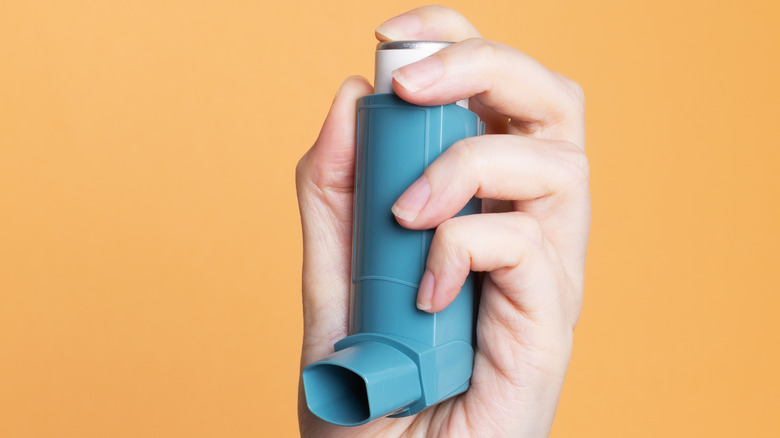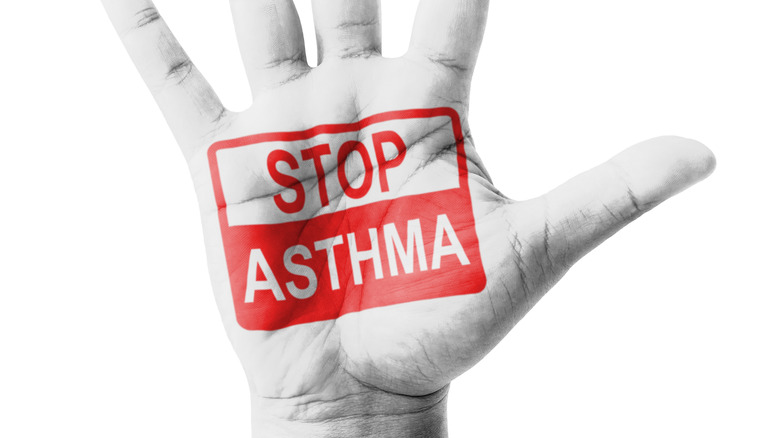Everything You Need To Know About Allergic Asthma
Our bodies comprise of multiple organ systems that work together to help us go about our daily lives. These systems work as one unit, 24 hours a day, seven days a week; and each one of them plays a unique role in making sure our bodies are functioning well. Some of these vital functions include thinking, breathing, moving, and digesting food. The systems responsible for these functions are easy enough to recognize, unlike some of the other ones. One such system that we don't often pay much attention to — at least until we get sick — is the immune system.
The immune system is made up of organs and specialized cells like the bone marrow, lymph nodes, spleen, and also the skin (per the Children's Hospital of Philadelphia). It is responsible for protecting our bodies against anything that is considered foreign or harmful. These can include viruses, bacteria, fungi, and other microorganisms. In other words, our immune system protects us from getting sick. Sometimes however, it incorrectly perceives a harmless substance as harmful. When this happens, the immune system will react even though it's not supposed to, and cause an allergy (via Cleveland Clinic). These harmless substances are appropriately referred to as allergens.
According to the Florida Medical Clinic, asthma is a long-term disease that causes the airways in your lungs to narrow and become inflamed. This occurs intermittently, often after exposure to a trigger. Depending on what the trigger is, asthma can generally be classified as allergic or non-allergic.
What is allergic asthma?
Christus Health explains that asthma and allergies don't always go hand in hand. If you have allergies, it doesn't mean that you automatically have asthma; and if you have asthma, it doesn't necessarily mean you have allergies. But MedlinePlus states that similar to allergies, asthma can also be triggered by allergens; and this type of asthma is specifically referred to as allergic asthma or extrinsic asthma.
Latest data from the Centers for Disease Control and Prevention (CDC) shows that as of 2020, 5.8% of children and 8.4% of adults in the United States have asthma. Those numbers may seem small, but when taken together, it is equivalent to over 25 million Americans. When analyzing the data according to sex, more females (9.5%) have asthma compared to males (6.1%). In terms of race and ethnicity, Asians have the lowest percentage at 3.5%, followed by Hispanics (6.7%), Whites (8.1%), Blacks (10.3%), American Indian and Alaska Natives (11.3%), and other single or multiple races (13.8%).
Among these numbers, 90% of children and 50% of adults with asthma have allergies that can trigger an asthma attack, which makes allergic asthma the most common type of asthma (per WebMD).
Causes and triggers of allergic asthma
The exact cause of allergic asthma is not well-known. It's not because of lack of research; in fact, many studies have been done in order to better understand how a person develops asthma. However, the results of these studies show that the cause of asthma involves multiple factors, most likely including a person's genetic makeup as well as the environment they're in. According to MedlinePlus, research on asthma over the years linked more than 100 genes to its development, but it seems like each of them only plays a role in specific populations. Additionally, exposure to certain environmental factors can trigger a change in some people's DNA, which in turn may cause them to develop allergies.
Even though we don't have a clear picture of what causes allergic asthma, we do know that it's triggered by allergens. According to the Asthma and Allergy Foundation of America (AAFA), some of the most common allergens that can trigger an allergic asthma attack include cockroaches (specifically their feces, saliva, and body parts), dust mites (insects that can be found in mattresses, carpets, stuffed toys, and other fabrics), mold (can be found indoors and outdoors), animals (especially their urine, feces, saliva, hair, and skin flakes), and pollen (found in plants and trees).
WebMD adds that apart from allergens, other irritants can also cause an asthma attack, they just won't cause an allergic reaction. These include air pollution, cold air, exercise, scented products, fumes, and smoke.
Risk factors for developing allergic asthma
Like many other health conditions, there are two types of risk factors for allergic asthma — those that you can't change (nonmodifiable) and those that you can change (modifiable). Nonmodifiable risk factors include your age, gender, family history, and personal history of atopy or other allergies. According to WebMD, asthma that occurs in childhood is more common in boys. At around 20 years old, the incidence of asthma in men and in women is close to equal. By age 40, everything flips and more women are found to have asthma compared to men. In terms of family history, per the American Lung Association, your risk of developing asthma increases three- to six-fold if you have a parent or parents who have asthma. Thanks, Mom and Dad!
Additionally, atopy is a term used to describe a condition that makes a person susceptible to developing eczema, allergic rhinitis, allergic conjunctivitis, and asthma (via WebMD). A person with atopy is particularly sensitive to allergens, making them prone to developing the atopic conditions.
Modifiable risk factors for asthma include obesity, smoking, viral respiratory infections in infants and children, and exposure to air pollution, dust, fumes, and chemicals. By maintaining a healthy weight, not smoking, and protecting yourself from environmental exposures, you can minimize your risk of having an asthma attack, or reduce its severity.
Signs and symptoms of allergic asthma
Asthma presents with the same symptoms, regardless if a person has the allergic or non-allergic subtype. However, asthma symptoms and the frequency at which they occur may be different from person to person. The AAFA states that an asthma attack occurs when the airways become narrow from swelling and inflammation following exposure to a trigger. This can cause a person to have shortness of breath, cough, chest pain or tightness, wheezing, and nocturnal awakenings due to symptoms. In addition, if you are using a peak flow meter, a reliable sign that you are experiencing an asthma attack is a drop in your reading compared to your baseline level.
An asthma attack can last from anywhere between a few minutes to a few days. The severity of an attack also varies among different individuals and specific episodes. Healthline adds that if you have allergy symptoms (from skin exposure, inhalation, or ingestion) along with your asthma symptoms, you may also develop itchiness of the skin and eyes, a rash or hives, flaky skin, runny nose, congestion, watery eyes, tingling sensation in your mouth, and swelling of your face, mouth, tongue, throat, or lips.
Diagnosing allergic asthma
A doctor can determine if you have allergic asthma by looking into your medical history, conducting a physical examination, and ordering specific tests. Doctors who specialize in the management of asthma include allergists and pulmonologists. The Allergy & Asthma Network explains that by looking at your personal and family history, your doctor can determine if you have risk factors that make you more susceptible to asthma compared to other people. During your physical examination, your doctor will listen for any abnormalities in your breathing, check your vital signs, and examine your body for other signs that are associated with allergies, asthma, and other atopic conditions.
You may also need to undergo some tests to confirm if you have allergic asthma. A blood test or skin test may be done to check what substances you're allergic to and how your body reacts to certain types of allergens. Spirometry is a breathing test where you inhale and exhale through a tube, and a machine analyzes how well the air flows as you breathe. This test assesses how well your lungs are working. An exhaled nitric oxide test (FeNO test) measures how much nitric oxide you have in your lungs. It can help your provider decide what treatment is best for you. Lastly, a bronchoprovocation test can be done if all other tests show inconclusive results (via Cleveland Clinic). Your doctor will ask you to inhale small samples of different allergens to determine which one will cause symptoms.
Treating and managing allergic asthma
Unfortunately, there's no cure for asthma. But the good news is, it can be controlled using various combinations of asthma medication. Most people keep their asthma symptoms at bay using two different types of drugs — a fast-acting rescue inhaler (bronchodilators) and a long-acting control inhaler (corticosteroids). According to WebMD, bronchodilators are used every time you have an asthma attack. They quickly act to open up your airways to relieve symptoms, and their effects last for four to six hours. A commonly used bronchodilator is albuterol. On the other hand, inhaled corticosteroids are taken regularly, once a day, to make sure that your asthma is well-controlled. Examples include fluticasone, budesonide, and mometasone.
Other classes of drugs can be added to your treatment if you continue to experience symptoms. Long-acting bronchodilators such as salmeterol and formoterol can also be used as a controller medication. They're similar to rescue inhalers, but their effects can last up to 12 hours. They should be used twice a day and should never be the only drug you use to control your asthma. You should continue using inhaled corticosteroids even if you're on a long-acting bronchodilator. If you have severe asthma, antileukotrienes like montelukast can also be added to your treatment (via WebMD). When all else fails, you may need to receive immunotherapy (i.e., allergy shots) for mild-to-moderate asthma, or take biologics for severe asthma. Your doctor will adjust your regimen based on your response to your current treatment.
Can allergic asthma be prevented?
Asthma as a disease is not preventable, but asthma attacks or flare-ups can be prevented and controlled. Aside from taking the appropriate medications prescribed by your doctor, there are several ways you can protect yourself from developing symptoms. The Cleveland Clinic advises people with asthma to learn how to identify what allergens trigger an attack, so that they can come up with ways to avoid them. Every person with asthma should also have an Asthma Action Plan. It is a written document that lists down important information about you and your asthma, and it also serves as a guide on how to manage your symptoms according to severity. You should have your Asthma Action Plan with you at all times.
If you are a parent of a child with asthma, the CDC says that it's important for your child's health and safety to let their school, caregivers, and other family members know about their asthma, what symptoms they experience, and their Asthma Action Plan. That way, even during times when you aren't with them, you know that they will be well taken care of.
The AAFA also recommends going to regular visits to your doctor. This ensures that your asthma is continuously well-controlled, and that the medications you're taking are appropriate for you. Adults and children alike should also be updated with their vaccinations. Infections can trigger and worsen asthma, especially those involving your respiratory tract like colds or the flu.
Will I have allergic asthma forever?
Asthma causes permanent changes to your airways. It's a chronic condition with no cure, which means that people who have asthma will have it for the rest of their lives (via Healthline). But a life with asthma can look different among people, since quality of life is dependent on how severe the asthma is and how well the symptoms are being controlled.
Although asthma can't be cured, experts are now entertaining the idea of asthma in remission. Being in remission is not the same as being cured, but it is the best outcome you can hope for. Currently, there's still no universally accepted definition for asthma remission, but a group of experts published a 2020 review in the Journal of Allergy and Clinical Immunology where they proposed to define it as going 12 or more months without symptoms, without having to use inhaled corticosteroids, and showing improvements in lung function through objective tests. The authors recognize that this definition is premature and should be open to further modifications.
Indeed, a 2022 review published in the European Respiratory Journal suggested adding the absence of rescue inhaler use as part of the definition as well. According to the authors, remission is a possible outcome in the natural course of asthma. You're more likely to achieve this if you have mild and early-onset asthma, have better lung function and asthma control, are younger, have a shorter duration of asthma, have fewer comorbidities, and never smoked or have stopped smoking.
Complications of allergic asthma
According to the CDC, it's possible to live a normal life with asthma, as long as it's well-controlled. But for people who have severe symptoms, life can be challenging. Not only might you have difficulty performing daily activities, but you may also have more visits to the emergency department, require hospitalizations, and have to miss school or work. These in turn create a heavy financial burden. In some cases, these problems can avoided by continuously working with your doctor in effectively managing your symptoms. Unfortunately, as of 2020, as many as 44% of children and 60% of adults with asthma don't have it under control.
Healthline warns that uncontrolled asthma can cause many complications. Your sleep can easily get disrupted because of your symptoms, and you may find it difficult to regularly exercise. When you lack sleep and don't exercise enough, your body becomes weak and you become more prone to diseases like diabetes and hypertension. In addition, children with asthma are more likely to experience growth delays and learning disabilities, and adults have an increased risk of depression. Asthma.net also adds that adults with asthma are five times more likely to develop chronic obstructive pulmonary disease (COPD).
A devastating complication of allergic asthma in particular is anaphylaxis, a severe and life-threatening allergic reaction that can cause hives, swelling of the airways (which eventually makes it hard to breathe), low blood pressure, diarrhea, nausea, vomiting, confusion, dizziness, and loss of consciousness (via Mayo Clinic).
Warning signs of an allergic asthma attack
Early warning signs suggest the possibility of having an allergic asthma attack. It's important to know that not everyone will have warning signs, they can vary greatly from person to person, and they are not exclusive to asthma alone. The Asthma & Allergy Center includes the following as early warning signs of acute asthma: difficulty breathing, shortness of breath, wheezing, chest tightness, coughing, sore or itchy throat, runny nose, sneezing, ear pain, watery eyes, stomach pain, itchy skin, irritability, headache, fatigue, and weakness.
If you have already been diagnosed with asthma, it's important for you to regularly pay close attention to how you're feeling. A severe asthma attack unrelieved by medications can be deadly and should be treated immediately in the hospital. Asthma.com advises people with asthma to seek emergency care as soon as possible if they are experiencing any of the following warning signs: severe symptoms, symptoms not responding to medication, pale or blue lips and fingers, or difficulty walking or talking because of shortness of breath.
A person experiencing a life-threatening asthma attack can be recognized as someone with a peak expiratory flow rate of less than 33% (normal is 80% and above), a blood oxygen saturation of less than 92% (normal is 94% and above), bluish discoloration of the skin, an irregular heart rhythm, a slow pulse, low blood pressure, weak respiratory muscles, confusion, and coma (via Asthma). People who experience this have an increased risk of death.
What is non-allergic asthma?
As the name implies, the difference between allergic and non-allergic asthma is the trigger that causes the symptoms. Even though asthma is divided into these two categories, they still present with very similar symptoms. Allergic asthma is triggered by allergens, whereas non-allergic asthma (aka intrinsic asthma) is triggered by things such as cold or dry air, exercise, heat, humidity, pollutants, smoke, fumes, chemicals, strong scents, stress, anxiety, infections, medications, and hormonal changes (via Asthma.net).
According to Healthline, compared to its allergic counterpart, non-allergic asthma is the less common type, has a tendency to occur later in life, affects more females than males, and is usually more severe in presentation. Because it isn't triggered by allergens, people who have non-allergic asthma will have no reactions to a skin test and most likely will not have any symptoms related to allergies. In these instances, your doctor may ask you to keep a journal to document your symptoms and what you were exposed to prior to your symptoms. By doing this, you may be able to identify what is triggering your asthma, and subsequently come up with a plan to avoid them in order to protect yourself from future attacks.
The hygiene hypothesis and allergic asthma
The hygiene hypothesis was proposed in 1989 by David Strachan, a public health professional who studies the causes of diseases (i.e., an epidemiologist). Authors of a 2006 review published in the Clinical & Experimental Allergy journal explains that the hygiene hypothesis initially started with an observation that the bigger the household, the less incidence of atopic conditions (e.g., asthma, eczema, allergic rhinitis), and vice versa. As years passed and more experts looked into this hypothesis, evidence shows that people who were exposed to fewer microorganisms when they were babies were more likely to develop atopic diseases. Dr. Strachan suggested that one of the reasons why this lack of exposure happens is because we now have better household hygiene practices.
So is there really such a thing as being too clean? A 2016 review published in Perspectives in Public Health warns people of the dangers of the hype that surrounds the hygiene hypothesis. While it's true that our bodies normally have microbes that are beneficial to us, and lack of exposure early in life can predispose us to allergic conditions, it's also true that not practicing good hygiene leads to spread of deadly infections. The key is knowing what exposures are safe and beneficial, and what kind of hygiene practices are appropriate. According to the researchers from the study, strategies like natural childbirth, breastfeeding, and increased contact exposure through outdoor activities can give a child the microbial exposure they need, all while not sacrificing proper hygiene.
Does having allergic asthma increase my risk of getting COVID-19?
Although the CDC warns that people with moderate-to-severe or uncontrolled asthma are at an increased risk of getting hospitalized from COVID-19, the American Academy of Allergy, Asthma, & Immunology (AAAAI) clarifies that to date, the majority of studies show that asthma does not increase your risk of severe COVID-19 disease.
Interestingly, results from a 2022 study published in the Proceedings of the National Academy of Sciences (PNAS) show that people with allergic asthma may actually be less likely to develop severe COVID-19. The researchers found that interleukin-13 (IL-13), a substance secreted by people with allergic asthma, altered the surroundings of the COVID-19 virus in a way that blunted the virus' ability to enter, multiply, and spread within the cells of the human body. This finding is reflective of the results of another study published a year before in the UK journal Thorax.
Although this sounds like good news, it's important to remember that it may take years, even decades, to understand diseases like COVID-19 through research. Therefore, the AAAAI encourages people with asthma to continue taking their medications as they normally would, unless advised otherwise by their doctor.
Conditions that may look like asthma
A lot of conditions can have similar symptoms to asthma (via WebMD). COPD is a long-term disease that also affects the airways. It presents very similarly to asthma, but COPD symptoms tend to be progressive and worsen over time, unlike in asthma where symptoms may come and go. Obstruction in the upper airways by an enlarged thyroid or tumors can also cause symptoms of asthma, such as wheezing. Congestive heart failure causes fluid to build up in the lungs, and when this happens, a person can experience shortness of breath and difficulty exercising, just like they would with asthma. Heartburn from acid reflux is also known to cause asthma symptoms. When acid goes back up through the esophagus, the nerves send a signal to your brain to protect your airway, causing them to narrow and lead to classic symptoms of asthma. Sinusitis is inflammation of your sinuses, and may present with a congested nose, facial pain, headache, and fatigue (per the Florida Medical Clinic). Unlike asthma, sinusitis is not a permanent disease. According to a 2022 article published in the Medical Journal of Australia, problems with your vocal cord (larynx), panic attacks, and hyperventilation can also present with the same symptoms as asthma.
If you are experiencing symptoms, whether it's due to asthma or another disease that mimics it, your health care provider will be able to determine the cause of your symptoms and provide you with the appropriate treatment.















